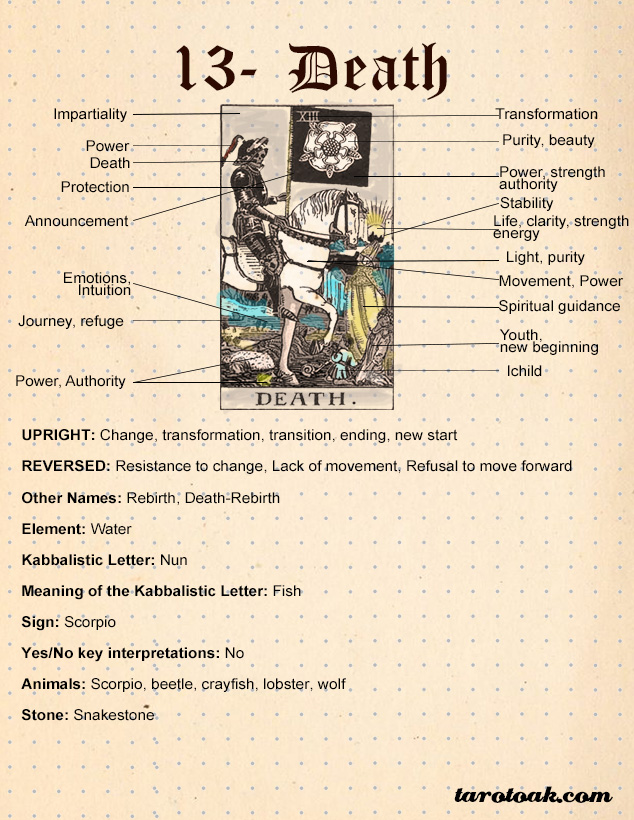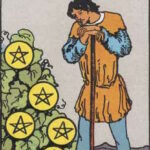The Death tarot card, an enigmatic emblem often surrounded by profound misconceptions, evokes a spectrum of emotions ranging from fear to curiosity. In the Christian perspective, its implications extend beyond the superficial interpretation of mortality. The deeper meanings reflect on themes of transformation, renewal, and the eternal cycle of life, echoing Christian doctrines while offering insights into the human condition.
In Christianity, the concept of death is paradoxically viewed as a gateway rather than a terminus. The Resurrection of Christ stands at the heart of this belief, symbolizing the defeat of death and the promise of eternal life. Thus, the Death card, typically marked by images of a skeletal figure and a chariot, may resonate with Christians as a reminder of Christ’s conquering of death. This juxtaposition compels believers to acknowledge death not as an end, but rather a passage to another phase of existence.
Throughout the Bible, death is portrayed multifacetedly. It serves as both a divine punishment for sin and a transformative experience that can lead to redemption and spiritual awakening. For instance, consider Romans 6:23, where the Apostle Paul articulates, “For the wages of sin is death, but the gift of God is eternal life in Christ Jesus our Lord.” The relationship between sin and death introduces a crucial understanding that often parallels the essence of the Death tarot card: the cessation of one phase paves the way for a new beginning.
Furthermore, the imagery of the Death card invites contemplation about the cyclical nature of life, akin to the seasons changing in their relentless march. Just as winter must yield to spring, individuals may encounter their own seasons of discontent that precede transformation. This concept resonates deeply with Christians who believe that suffering and trials are often precursors to spiritual rebirth, paralleling the resurrection narrative that defines their faith.
Another significant aspect of the Death card is the notion of letting go. In a Christian context, this embodies the call to relinquish worldly attachments and embrace a life devoted to spiritual pursuits. Matthew 16:24 states, “Whoever wants to be my disciple must deny themselves and take up their cross and follow me.” The card symbolizes the necessity of surrendering old habits, relationships, and even identities that no longer serve a holy purpose, much like the purification process of the soul advocated in Christianity.
The reconciliation of death with life also evokes profound theological discussions within Christianity. The practice of memento mori, or remembering death, serves as a sobering reminder to live a life imbued with purpose and faith. The Death tarot card echoes this sentiment, urging individuals to reflect on their life choices and spiritual integrity. When viewed through such a lens, the card serves as a mirror reflecting the soul’s condition and an invitation to reassess one’s commitments to God and community.
Moreover, the Death card’s representation of endings and new beginnings can be likened to the Christian belief in the promise of salvation. Just as Christ’s death leads to resurrection, the Death tarot card teaches that every ending can be a precursor to a new chapter. This lesson resonates with several biblical narratives, such as the story of Lazarus, who, after being raised from the dead, exemplifies the transformative power of faith and divine intervention. Such stories embody the idea that death, whether literal or metaphorical, can lead to miraculous rejuvenation.
The card also invites exploration into the themes of judgement and moral introspection inherent in Christian theology. The end of life on earth ushers in the promise of divine judgement. The Death card, therefore, challenges believers to consider their earthly existence and divine accountability. Revelations 20:12 coins the idea of a final reckoning, inciting Christians to lead lives reflective of their moral beliefs. It could be suggested that the Death card urges its beholder to not only prepare for death but also to embrace a life of righteousness, a notion deeply embedded in Christian doctrine.
Many Christians approach the Death tarot card with trepidation, shaped by societal norms and skewed interpretations of occult practices. Yet, by excavating the layers of its meaning, believers can glean valuable lessons that transcend the stigma once associated with it. The tarot can serve as a catalyst for self-examination, prompting introspective reflections that align with biblical teachings regarding life, death, and resurrection.
Ultimately, the Death tarot card, when embraced from a Christian perspective, unfolds as a complex tapestry woven with the threads of transformation, rebirth, and renewal. It beckons individuals to confront their own mortality while also elevating their spiritual consciousness. By recognizing death not just as a final cessation but as an integral aspect of their spiritual voyage, individuals can foster a deeper relationship with their faith, fortifying their resilience against life’s inevitable challenges.
In conclusion, the Death tarot card serves as a profound reminder of the cyclical nature of existence—a narrative that Christians hold dear. Rather than shunning its symbolism, believers might find enlightenment in its call for growth, as it aligns seamlessly with the central tenets of Christian faith. As they navigate their spiritual journey, the themes echoed by this card can inspire a more profound understanding of life’s purpose, reinforcing the belief that even in the face of death, life continues in a different, yet eternal form.









Leave a Comment